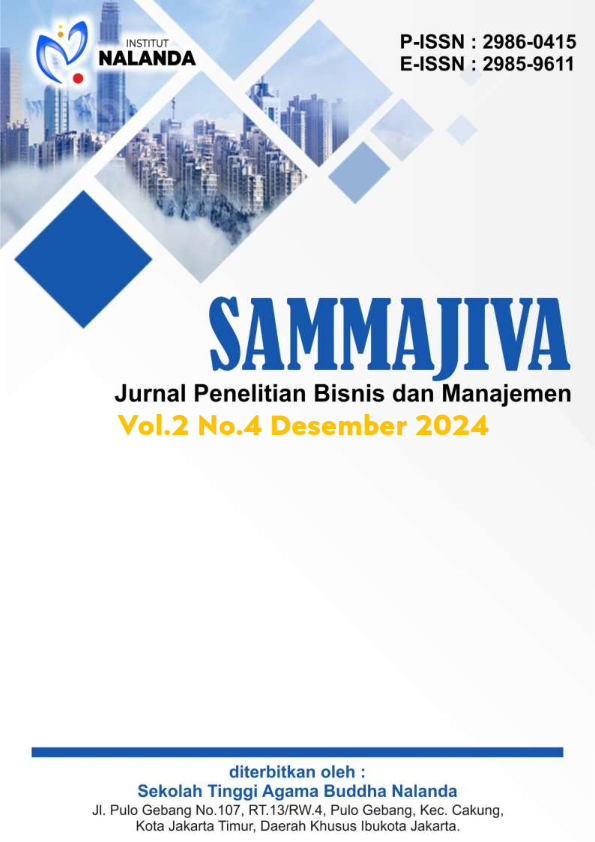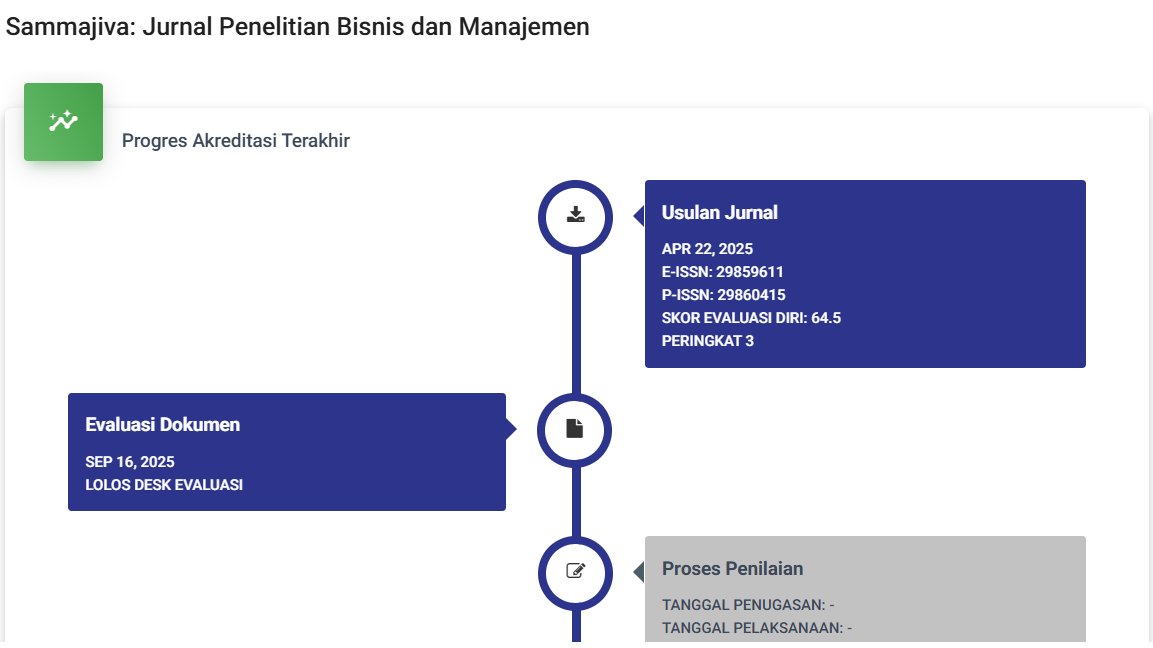Pengaruh Persepsi Kualitas Medis Terhadap Kepercayaan Melalui Kepuasan Pelanggan Klinik Seby Cirebon
DOI:
https://doi.org/10.47861/sammajiva.v2i4.1605Keywords:
Perception of medical quality, trust, satisfactionAbstract
This study aims to analyze the effect of perceived medical quality on customer trust by considering satisfaction as a mediating variable. This study uses an explanatory research method, which focuses on explaining the relationship between variables through hypothesis testing. The population in this study were customers who used services at the Seby Clinic in Cirebon. The sampling technique was carried out using the nonprobability sampling method, using the accidental sampling approach, with a total sample of 135 respondents. Data analysis was carried out using the path analysis method. The results of the study indicate that both perceived medical quality have a significant effect on customer satisfaction and trust. In addition, customer satisfaction also has a significant impact on increasing customer trust. Furthermore, customer satisfaction acts as a significant mediator in the relationship between perceived medical quality and customer trust.
References
Arikunto, S. (2010). Prosedur penelitian: Suatu pendekatan praktik. Jakarta: Rineka Cipta.
Barnes, J. G. (2003). Secrets of customer relationship management (Rahasia manajemen hubungan pelanggan). Yogyakarta: Andi.
Basari, M. T. (2019). Data pertumbuhan ekonomi Indonesia kuartal I/2019. Bisnis.com. https://ekonomi.bisnis.com/read/20190506/9/919120/data-pertumbuhan-ekonomi-indonesia-kuartal-i2019
Bernstein, N. (2012). Chefs, butlers, marble baths: Hospitals vie for the affluent. The New York Times. Retrieved March 15, 2013, from http://www.nytimes.com/2012/01/22/nyregion/chefs-butlers-and-marble-baths-not-your-average-hospital-room.html
Bitner, M. J., Booms, B. H., & Tetreault, M. S. (1990). The service encounter: Diagnosing favorable and unfavorable incidents. Journal of Marketing, 54(1), 71-84. https://doi.org/xxxxx
Bowen, J. T., & Chen, S. (2001). The relationship between customer loyalty and customer satisfaction. International Journal of Contemporary Hospitality Management, 13(4), 213-217. https://doi.org/xxxxx
Chiu, C., Hsu, M., Lai, H., & Chang, C. (2012). Re-examining the influence of trust on online repeat purchase intention: The moderating role of habit and its antecedents. Decision Support Systems, 53(4), 835-845. https://doi.org/xxxxx
Clemmer, J. (1990). The three rings of perceived value. Canadian Manager, 15, 12-15.
Cronin, J. J., & Taylor, S. A. (1992). Measuring service quality: A reexamination and extension. Journal of Marketing, 56, 55-68. https://doi.org/xxxxx
Gan, L. L., & Frederick, J. R. (2011). Medical tourism facilitators: Patterns of service differentiation. Journal of Vacation Marketing, 17(3), 165-183. https://doi.org/xxxxx
Ghozali, I. (2013). Aplikasi analisis multivariate dengan program SPSS (Edisi ketujuh). Semarang: Badan Penerbit Universitas Diponegoro.
Hair, J. F., Black, W. C., & Babin, B. J. (2010). Multivariate data analysis. United States of America: Pearson Education Limited.
Han, H. (2013). The healthcare hotel: Distinctive attributes for international medical travelers. Tourism Management, 36, 257-268. https://doi.org/xxxxx
Han, H., & Hwang, J. (2013). Multi-dimensions of the perceived benefits in a medical hotel and their roles in international travelers' decision-making process. International Journal of Hospitality Management, 35, 100-108. https://doi.org/xxxxx
Han, H., & Hyun, S. (2013). Image congruence and relationship quality in predicting switching intention: Conspicuousness of product use as a moderator variable. Journal of Hospitality and Tourism Research, 37(3), 303-329. https://doi.org/xxxxx
Han, H., & Hyun, S. S. (2015). Customer retention in the medical tourism industry: Impact of quality, satisfaction, trust, and price reasonableness. Tourism Management, 46, 20-29. https://doi.org/xxxxx
Han, H., & Ryu, K. (2007). Moderating role of personal characteristic in forming restaurant customers’ behavioral intentions: An upscale restaurant setting. Journal of Hospitality & Leisure Marketing, 15(4), 25-53. https://doi.org/xxxxx
Hume, L. F., & DeMicco, F. J. (2007). Bringing hotels to healthcare: A Rx for success. Journal of Quality Assurance in Hospitality and Tourism, 8(1), 75-84. https://doi.org/xxxxx
Ishak, A., & Luthfi, Z. (2011). Pengaruh kepuasan dan kepercayaan konsumen terhadap loyalitas: Studi tentang peran mediasi switching costs. Jurnal Siasat Bisnis, 15(1), 45-46.
Jiang, P., & Rosenbloom, B. (2005). Customer intention to return online: Price perception, attribute-level performance, and satisfaction unfolding over time. European Journal of Marketing, 39, 150-174. https://doi.org/xxxxx
Johnson, M. D., Anderson, E. W., & Fornell, C. (1995). Rational and adaptive performance expectations in a customer satisfaction framework. Journal of Consumer Research, 21, 128-140. https://doi.org/xxxxx
Kim, H. W., & Gupta, A. (2009). A comparison of purchase decision calculus between potential and repeat customers of an online store. Decision Support Systems, 47(4), 477-487. https://doi.org/xxxxx
Kotler, P., & Keller, K. L. (2016). Marketing management (Global Edition 15). United States of America: Pearson Education, Inc.
Lankton, N. K., Wilson, E. V., & Mao, E. (2010). Antecedents and determinants of information technology habit. Information & Management, 47(5), 300-307. https://doi.org/xxxxx
Lee, M., Han, H., & Lockyer, T. (2012). Medical tourism – attracting Japanese tourists for medical tourism experience. Journal of Travel & Tourism Marketing, 29(1), 69-86. https://doi.org/xxxxx
Marko, T., & Mudiantono. (2017). The impact of website design quality, service quality, and enjoyment on repurchase intention through satisfaction and trust at Zalora. Journal Name, 6(4), 1-11.
Mayer, R. C., Davis, J. H., & Schoorman, F. D. (1995). An integrative model of organizational trust. Academy of Management Review, 20(3), 709-734. https://doi.org/xxxxx
McColl-Kennedy, J. R., & Schneider, U. (2000). Measuring customer satisfaction: Why, what and how. Total Quality Management, 77(1), 1-7.
Morgan, R. M., & Hunt, S. D. (1994). The commitment-trust theory of relationship marketing. Journal of Marketing, 58(3), 20-38. https://doi.org/xxxxx
Mowen, J. C., & Minor, M. (2002). Perilaku konsumen. Erlangga.
Oh, H. (2000). The effect of brand class, brand awareness, and price on customer value and behavioral intentions. Journal of Hospitality & Tourism Research, 24(2), 136-162. https://doi.org/xxxxx
Oliver, R. L. (1997). Satisfaction: A behavioral perspective on the consumer. McGraw-Hill.
Parasuraman, A. (2013). Delivering quality service: Balancing customer reception and expectation. The Free Press.
Pavlou, P. A., Liang, H., & Xue, Y. (2007). Understanding and mitigating uncertainty in online exchange relationships: A principal-agent perspective. MIS Quarterly, 31(1), 105-136. https://doi.org/xxxxx
Personal Beauty Skincare. (2019). Peta lokasi Personal Beauty Skincare. Retrieved October 5, 2019, from https://petalokasi.org/Kabupaten-Cirebon/Personal-Beauty-Skincare-1924522/
Prasetya, C. H. A., Kumadji, S., & Yulianto, E. (2014). Pengaruh citra merek, kualitas produk terhadap kepercayaan serta keputusan pembelian (Survei pada pembeli sepeda motor Honda Vario pada PT Sumber Purnama Sakti di Kabupaten Gresik). Prosiding Seminar Nasional Manajemen dan Bisnis, Universitas Brawijaya.
Pratiwi, D. I. (2010). Analisis pengaruh harapan pelanggan, kualitas produk, kepuasan pelanggan terhadap loyalitas pelanggan internet Flash Unlimited di Semarang [Undergraduate thesis, Universitas Diponegoro].
Prayitno, D. (2010). Paham analisa data statistik dengan SPSS. Mediakom.
Price, L., Arnould, E., & Deibler, S. (1995). Consumers’ emotional responses to service encounters. International Journal of Service Industry Management, 6(3), 34-63. https://doi.org/xxxxx
Prihastono, E. (2012). Pengukuran kepuasan konsumen pada kualitas pelayanan customer service berbasis web. Jurnal Ilmiah Dinamika Teknik. Retrieved from https://download.portalgaruda.org
Rahayu, R. S., & Sharif, O. O. (2019). Customer value index analysis in choosing beauty clinic in Indonesia. e-Proceeding of Management, 6(1).
Razak, I., & Nirwanto, N. (2016). The impact of product quality and price on customer satisfaction with the mediator of customer value. Journal of Marketing and Customer Research, 30, 1-10.
Riduwan, & Kuncoro. (2007). Cara menggunakan dan memaknai analisis jalur (Path Analysis). Alfabeta.
Ryu, K., & Han, H. (2009). Influence of the quality of food, service, and physical environment on customer satisfaction and behavioral intention in quick-casual restaurants: Moderating role of perceived price. Journal of Hospitality & Tourism Research, 34(3), 310-329. https://doi.org/xxxxx
Santos, C. P., & Basso, K. (2012). Do ongoing relationships buffer the effects of service recovery on customers' trust and loyalty? International Journal of Bank Marketing, 30(3), 168-192. https://doi.org/xxxxx
Sheehan-Smith, L. (2006). Key facilitators and best practices of hotel-style room service in hospitals. Journal of the American Dietetic Association, 106(4), 581-586. https://doi.org/xxxxx
Sinambela, L. P. (2010). Reformasi pelayanan publik: Teori, kebijakan, dan implementasi. PT Bumi Aksara.
Sirdeshmukh, D., Singh, J., & Sabol, B. (2002). Consumer trust, value, and loyalty in relational exchanges. Journal of Marketing, 66(1), 15-37. https://doi.org/xxxxx
Snyder, J., Crooks, V. A., Adams, K., Kingsbury, P., & Johnston, R. (2011). The patient's physician one-step removed: The evolving roles of medical tourism facilitators. Journal of Medical Ethics, 37(7), 530-534. https://doi.org/xxxxx
Sugiyono. (2017). Statistika untuk penelitian. Alfabeta.
Sugiyono. (2018). Metode penelitian kuantitatif. Alfabeta.
Taylor, S. A., & Baker, T. L. (1994). An assessment of the relationship between service quality and customer satisfaction in the formation of consumers’ purchase intentions. Journal of Retailing, 70(2), 163-178. https://doi.org/xxxxx
Tjiptono, F. (2012). Strategi pemasaran (2nd ed.). Andi Offset.
Tjiptono, F. (2014). Pemasaran jasa. Andi.
Utami, R. (2019). Analisis kualitas layanan internet banking untuk meningkatkan kepercayaan nasabah bertransaksi secara online (Studi pada Bank NTB Syariah Cabang Pemenang KLU) [Undergraduate thesis, Universitas Islam Negeri Mataram].
Utari, W., & Hidayat. (2019). Membangun kepercayaan pasien melalui kualitas layanan, image, dan kepuasan pasien. Jurnal Olahraga dan Literasi Kesehatan Universitas Wijaya Putra Surabaya, 1(1), 53-61.
Wijaya, T. (2005). Pengaruh service quality perception dan satisfaction terhadap purchase intention. Jurnal Ekonomi dan Bisnis, 17(1), 39-52.
Wijaya, T. (2011). Manajemen kualitas jasa (1st ed.). PT Indeks.
Zeithaml, V. A., Berry, L. L., & Parasuraman, A. (2006). Delivering quality service.
Zeithaml, V. A., Bitner, M. J., & Gremler, D. D. (2009). Service marketing (5th ed.). McGraw-Hill.








